Items
-
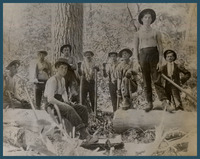 A logging crew along the Little River, near Bartow, Pocahontas County, WV. Working six days per week, often ten or more hours a day, crews of workers known as “wood hicks” cut and prepared hundreds of logs each day for transport to a sawmill. At the peak of West Virginia’s timber boom in 1909, men with job titles like choppers, sawyers, swampers, and knot bumpers earned between $1.75 and $2.00 per day.
A logging crew along the Little River, near Bartow, Pocahontas County, WV. Working six days per week, often ten or more hours a day, crews of workers known as “wood hicks” cut and prepared hundreds of logs each day for transport to a sawmill. At the peak of West Virginia’s timber boom in 1909, men with job titles like choppers, sawyers, swampers, and knot bumpers earned between $1.75 and $2.00 per day. -
 Maggie Hammons Parker at home in Stillwell, near Marlinton, Pocahontas County, West Virginia. The influence of the Hammons family on West Virginia folk life spans generations. However, wide recognition of their songs, stories, and traditions did not come until the 1970s when local musician Dwight Diller became closely acquainted with the Hammonses. Diller learned their music, practiced their traditions, and studied their history. His relationship with the Hammonses triggered interest among other musicians and folklorists, and his field recordings and interviews contributed to a study of the family produced by the Library of Congress in 1973. The Hammonses are recognized as central to the preservation of authentic musical styles and culture in the region. Recordings of their music have been released by WVU Press, the Library of Congress, Rounder Records, Dwight Diller, and the Augusta Heritage Center of Davis & Elkins College. Pictured here, Maggie Hammons Parker was a matriarch of the family and one of five Hammonses inducted into the West Virginia Music Hall of Fame in 2020.
Maggie Hammons Parker at home in Stillwell, near Marlinton, Pocahontas County, West Virginia. The influence of the Hammons family on West Virginia folk life spans generations. However, wide recognition of their songs, stories, and traditions did not come until the 1970s when local musician Dwight Diller became closely acquainted with the Hammonses. Diller learned their music, practiced their traditions, and studied their history. His relationship with the Hammonses triggered interest among other musicians and folklorists, and his field recordings and interviews contributed to a study of the family produced by the Library of Congress in 1973. The Hammonses are recognized as central to the preservation of authentic musical styles and culture in the region. Recordings of their music have been released by WVU Press, the Library of Congress, Rounder Records, Dwight Diller, and the Augusta Heritage Center of Davis & Elkins College. Pictured here, Maggie Hammons Parker was a matriarch of the family and one of five Hammonses inducted into the West Virginia Music Hall of Fame in 2020. -
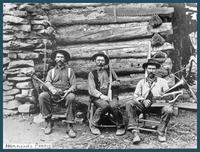 Pete, Paris, and Neal Hammons Taken in 1906 along the Williams River in Webster County, this photograph features members of the Hammons family—brothers Pete, Paris, and Neal—posing with a fiddle, gun, and phonograph. Known for their distinctive old-time musical sound, their knowledge of mountain lore, and their traditional way of life, the Hammons family embodies the culture and sound of the West Virginia frontier. According to folklorist and musician Gerry Milnes, “The three brothers seem to be making a calculated statement by holding items of importance and usefulness.” Milnes notes that the inclusion of the phonograph “belies any argument that this family was musically isolated from the rest of the world,” contradicting the stereotype of mountaineers as culturally secluded from the rest of the world.
Pete, Paris, and Neal Hammons Taken in 1906 along the Williams River in Webster County, this photograph features members of the Hammons family—brothers Pete, Paris, and Neal—posing with a fiddle, gun, and phonograph. Known for their distinctive old-time musical sound, their knowledge of mountain lore, and their traditional way of life, the Hammons family embodies the culture and sound of the West Virginia frontier. According to folklorist and musician Gerry Milnes, “The three brothers seem to be making a calculated statement by holding items of importance and usefulness.” Milnes notes that the inclusion of the phonograph “belies any argument that this family was musically isolated from the rest of the world,” contradicting the stereotype of mountaineers as culturally secluded from the rest of the world. -
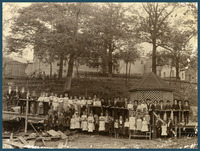 Subscription School Students and Teachers, West Virginia. Though often viewed by the popular press as backward and isolated, historians have consistently shown that Appalachia was connected to the broader national economy and culture. Often following the lead of middle-class reformers, many residents came to believe that both education and industrial development were essential to the advancement of the region. As part of their pursuit of education, some rural communities offered subscription singing schools where adults and children could learn to sing using a form of written music called “shape notes.” Families paid a subscription fee to compensate a traveling music teacher for group lessons that ran about two weeks.
Subscription School Students and Teachers, West Virginia. Though often viewed by the popular press as backward and isolated, historians have consistently shown that Appalachia was connected to the broader national economy and culture. Often following the lead of middle-class reformers, many residents came to believe that both education and industrial development were essential to the advancement of the region. As part of their pursuit of education, some rural communities offered subscription singing schools where adults and children could learn to sing using a form of written music called “shape notes.” Families paid a subscription fee to compensate a traveling music teacher for group lessons that ran about two weeks. -
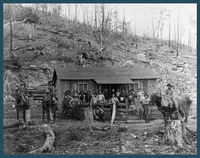 Logging Camp, Pocahontas County, West Virginia. Notice the loggers holding banjos at this Pocahontas County logging camp. Fiddles and banjos were the most common instruments in traditional Appalachian music for many decades; guitar accompaniment did not become popular until the twentieth century.
Logging Camp, Pocahontas County, West Virginia. Notice the loggers holding banjos at this Pocahontas County logging camp. Fiddles and banjos were the most common instruments in traditional Appalachian music for many decades; guitar accompaniment did not become popular until the twentieth century. -
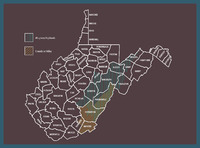 Map of the Allegheny Highlands and Greenbrier River Valley of West Virginia Two overlapping, regional designations play essential roles in this history of West Virginia’s timber industry. Home to a magnificent variety of hardwoods and softwoods, the Allegheny Highlands include the highest peaks in the Allegheny Mountains. Today, much of this area is part of the Monongahela National Forest. The counties of the Allegheny Highlands are fed by multiple river systems, one of which forms the Greenbrier River Valley. The river systems, and later railroads, connected the Greenbrier Valley with the Allegheny Highlands, forming a transportation and trade network that also linked the region to neighboring counties, such as Braxton and Clay.
Map of the Allegheny Highlands and Greenbrier River Valley of West Virginia Two overlapping, regional designations play essential roles in this history of West Virginia’s timber industry. Home to a magnificent variety of hardwoods and softwoods, the Allegheny Highlands include the highest peaks in the Allegheny Mountains. Today, much of this area is part of the Monongahela National Forest. The counties of the Allegheny Highlands are fed by multiple river systems, one of which forms the Greenbrier River Valley. The river systems, and later railroads, connected the Greenbrier Valley with the Allegheny Highlands, forming a transportation and trade network that also linked the region to neighboring counties, such as Braxton and Clay. -
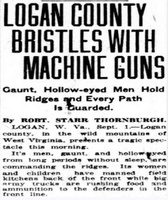 Families Transport Food Image 2 of The Washington times (Washington [D.C.]), September 1, 1921, (FINAL HOME EDITION) This text features an article detailing how women and children manned the kitchens during the strikes, supplying miners with food.
Families Transport Food Image 2 of The Washington times (Washington [D.C.]), September 1, 1921, (FINAL HOME EDITION) This text features an article detailing how women and children manned the kitchens during the strikes, supplying miners with food. -
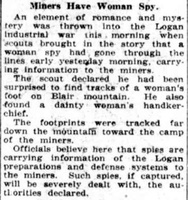 Miners Have Woman Spy This excerpt from the Washington Times details rumors of a woman being responsible for aiding the striking miners with inside intelligence to use to their advantage. In other words, this article is proof that women were unsuspected contributors to the fight at Blair Mountain.
Miners Have Woman Spy This excerpt from the Washington Times details rumors of a woman being responsible for aiding the striking miners with inside intelligence to use to their advantage. In other words, this article is proof that women were unsuspected contributors to the fight at Blair Mountain. -
 AFL CIO Seal, West Virginia Seal of the American Federation of Labor and Congress of Industrial Organizations
AFL CIO Seal, West Virginia Seal of the American Federation of Labor and Congress of Industrial Organizations -
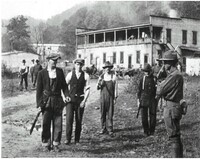 Miners Camping at Blair Image of miners camping at Blair Mountain
Miners Camping at Blair Image of miners camping at Blair Mountain -
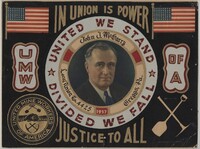 "In Union is Power" poster Picture of poster UMWA 1897-1983, Historical Collections and Labor Archives, Special Collections Library, University Libraries, Pennsylvania State University.
"In Union is Power" poster Picture of poster UMWA 1897-1983, Historical Collections and Labor Archives, Special Collections Library, University Libraries, Pennsylvania State University. -
 Local Miner with Rifle Local miner with rifle photograph.
Local Miner with Rifle Local miner with rifle photograph. -
 Sheriff and 11 Others are Killed in Fight at Mine Near Wellsburg, The West Virginian Front Page 7.17.1922 The West Virginian. (Fairmont, W. Va.), 17 July 1922. Chronicling America: Historic American Newspapers. Lib. of Congress.
Sheriff and 11 Others are Killed in Fight at Mine Near Wellsburg, The West Virginian Front Page 7.17.1922 The West Virginian. (Fairmont, W. Va.), 17 July 1922. Chronicling America: Historic American Newspapers. Lib. of Congress. -
 Non-Union Men Working at Top Speed in W. VA, The West Virginian 7.17.1992 This newspaper, The West Virginian, of Fairmont, W.V., main title describes a standoff between 500 miners and the authorities of Brooke County. The Sheriff H.H. Duvall and eleven miners were killed in the gunfight near Cliftonville. The date is July 17, 1922.
Non-Union Men Working at Top Speed in W. VA, The West Virginian 7.17.1992 This newspaper, The West Virginian, of Fairmont, W.V., main title describes a standoff between 500 miners and the authorities of Brooke County. The Sheriff H.H. Duvall and eleven miners were killed in the gunfight near Cliftonville. The date is July 17, 1922. -
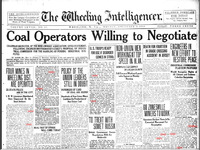 Coal Operators Willing to Negotiate, Front Page of The Wheeling Intelligencer 11.3.1919 Front page of The Wheeling intelligencer. Vol. LXVIII, No. 61 (Wheeling, W. Va.), 03 Nov. 1919. Chronicling America: Historic American Newspapers. Lib. of Congress.
Coal Operators Willing to Negotiate, Front Page of The Wheeling Intelligencer 11.3.1919 Front page of The Wheeling intelligencer. Vol. LXVIII, No. 61 (Wheeling, W. Va.), 03 Nov. 1919. Chronicling America: Historic American Newspapers. Lib. of Congress. -
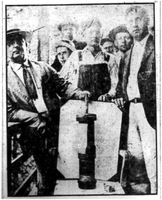 A Bomb Dropped on Miners Miners showcase a bomb they claim was dropped on them from one of Chafin's planes. The fighting on Blair Mountain became so intense and entrenched that Chafin, the leader of the anti-union defense forces, saw fit to drop bombs on miners from planes. This image demonstrates to intensity of the fight and how serious it became. (http://www.wvculture.org/history/labor/mwnews.html)
A Bomb Dropped on Miners Miners showcase a bomb they claim was dropped on them from one of Chafin's planes. The fighting on Blair Mountain became so intense and entrenched that Chafin, the leader of the anti-union defense forces, saw fit to drop bombs on miners from planes. This image demonstrates to intensity of the fight and how serious it became. (http://www.wvculture.org/history/labor/mwnews.html) -
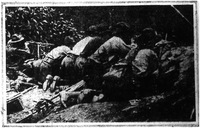 Fighting at Blair Mountain Here, we see a group of men loyal to Chafin repulsing an attack by the miners. Lines of temporary fortifications like this extended all along the Logan-Boone county border. Machine guns were used to keep the miners, many of whom had fought in former American wars, at bay. (http://www.wvculture.org/history/labor/mwnews.html) Charleston Gazette, 10 September 1921
Fighting at Blair Mountain Here, we see a group of men loyal to Chafin repulsing an attack by the miners. Lines of temporary fortifications like this extended all along the Logan-Boone county border. Machine guns were used to keep the miners, many of whom had fought in former American wars, at bay. (http://www.wvculture.org/history/labor/mwnews.html) Charleston Gazette, 10 September 1921 -
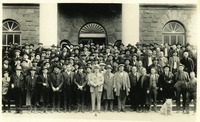 Chafin, Don and a Number of His Company's Paid Deputies An image of Don Chafin (marked by an X) standing with his men. Don Chafin lead armed opposition to the marching miners and organized resistance against the revolt at Blair Mountain. He and members of law enforcement and the local community formed a small army, better equipped than the miners.
Chafin, Don and a Number of His Company's Paid Deputies An image of Don Chafin (marked by an X) standing with his men. Don Chafin lead armed opposition to the marching miners and organized resistance against the revolt at Blair Mountain. He and members of law enforcement and the local community formed a small army, better equipped than the miners. -
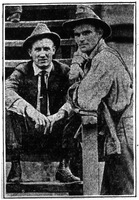 Picture of W. H. Blizzard (left) A picture of W. H. Blizzard, a leading organizer at the Battle of Blair Mountain (left). Bill Blizzard was considered a leader, if not the leader of the miners' army. Blizzard had been working to organize and unionize miners in West Virginia for years. He was later tried for his actions at the Battle of Blair Mountain. (http://www.wvculture.org/history/labor/mwnews.html)
Picture of W. H. Blizzard (left) A picture of W. H. Blizzard, a leading organizer at the Battle of Blair Mountain (left). Bill Blizzard was considered a leader, if not the leader of the miners' army. Blizzard had been working to organize and unionize miners in West Virginia for years. He was later tried for his actions at the Battle of Blair Mountain. (http://www.wvculture.org/history/labor/mwnews.html) -
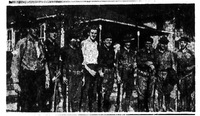 Logan Men Ready for Battle A group of men getting ready to fight in Logan County. The miners' army was primarily equipped with high-powered rifles and organized by union leaders. Chafin's men were better armed, with machine guns and a number of planes. (http://www.wvculture.org/history/labor/mwnews.html)
Logan Men Ready for Battle A group of men getting ready to fight in Logan County. The miners' army was primarily equipped with high-powered rifles and organized by union leaders. Chafin's men were better armed, with machine guns and a number of planes. (http://www.wvculture.org/history/labor/mwnews.html) -
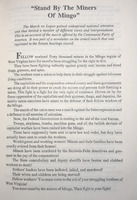 Letter of Support from the Communists A letter from the Communist Party of America in support of the labor movement in WV. At times, information regarding the level of organization around the Battle of Blair Mountain can be sparse. This document demonstrates the systematic nature of a lot that went down here, and how complex ideologies contributed to the genesis of many labor resistance movements. Taken from The West Virginia mine wars: An anthology.
Letter of Support from the Communists A letter from the Communist Party of America in support of the labor movement in WV. At times, information regarding the level of organization around the Battle of Blair Mountain can be sparse. This document demonstrates the systematic nature of a lot that went down here, and how complex ideologies contributed to the genesis of many labor resistance movements. Taken from The West Virginia mine wars: An anthology. -
 Socialist and Labor Star clipping A clipping from the Socialist and Labor Star. This clipping shows a pro-labor group describing incidents of government hostility from their own perspective. Miners had been building up years of resentment for hostility against them. Events like these were what led up to the fight at Blair Mountain.
Socialist and Labor Star clipping A clipping from the Socialist and Labor Star. This clipping shows a pro-labor group describing incidents of government hostility from their own perspective. Miners had been building up years of resentment for hostility against them. Events like these were what led up to the fight at Blair Mountain. -
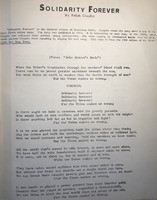 Solidarity Forever The lyrics to the anthem of American labor. Many are familiar with the Pete Seeger rendition of Solidarity Forever. What they may not be aware of is the fact that the song was inspired by events that occurred in West Virginia. Taken from Paint Creek Miner: Famous Labor Songs from Appalachia, by Charles Patterson.
Solidarity Forever The lyrics to the anthem of American labor. Many are familiar with the Pete Seeger rendition of Solidarity Forever. What they may not be aware of is the fact that the song was inspired by events that occurred in West Virginia. Taken from Paint Creek Miner: Famous Labor Songs from Appalachia, by Charles Patterson.
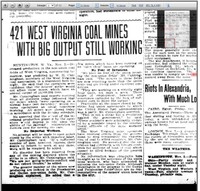 421 West Virginia Coal Mines with Big Output Still Working, [insert name of newspaper]
421 West Virginia Coal Mines with Big Output Still Working, [insert name of newspaper]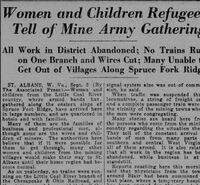 Women and children refugee tell of mine army gathering
Women and children refugee tell of mine army gathering